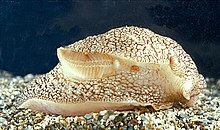
A ctenidium is a respiratory organ or gill which is found in many molluscs. This structure exists in bivalves, cephalopods, polyplacophorans (chitons), and in aquatic gastropods such as freshwater snails and marine snails.[1] Certain molluscs, such as the bivalves,[2] possess paired ctenidia, but others, such as members of the Ampullariidae,[3] bear a single ctenidium.[4][5]
A ctenidium is shaped like a comb or a feather, with a central part from which many filaments or plate-like structures protrude, lined up in a row. Some aquatic gastropods possess a single row of filaments on their ctenidium, known as the monopectinate condition,[3] and others have a pair of filament rows, known as the bipectinate or aspidobranch condition.[6] The ctenidium hangs into the mantle cavity and increases the area available for gas exchange.[7] The word is Latinized but is derived from the Greek ktenidion which means "little comb", being a diminutive of the word kteis meaning comb.
-
Pair of large, grey gills visible inside the mantle cavity of a giant squid
- ^ Ruppert, Edward E.; Fox, Richard S. & Barnes, Robert D. (2004). Invertebrate Zoology: A Functional Evolutionary Approach. Thomson-Brooks/Cole. p. 286. ISBN 978-0-03-025982-1.
- ^ Morton, Brian (18 March 2024). "Bivalve: Food and feeding". Encyclopedia Britannica. Retrieved 11 November 2024.
- ^ a b Rodriguez, Cristian; Prieto, Guido I.; Vega, Israel A. & Castro-Vazquez, Alfredo (2019). "Functional and evolutionary perspectives on gill structures of an obligate air-breathing, aquatic snail". PeerJ. 7: e7342. doi:10.7717/peerj.7342. PMC 6679647. PMID 31396441.
- ^ Bunje, Paul (2003). "Lophotrochozoa: The Mollusca, Sea slugs, squid, snails, and scallops". UC Museum of Paleontology. University of California Museum of Paleontology. Retrieved 11 November 2024.
- ^ Nordsieck, Robert (2012). "Respiration and Circulation". The Living World of Molluscs. Support and scripting by Martina Eleveld. Retrieved 11 November 2024.
- ^ "aspidobranch". Macrobenthos of the North Sea - Mollusca. Naturalis Biodiversity Center. Retrieved 11 November 2024.
- ^ Respiratory system Archived 2020-08-09 at the Wayback Machine The apple snail. Retrieved 2012-04-20.
